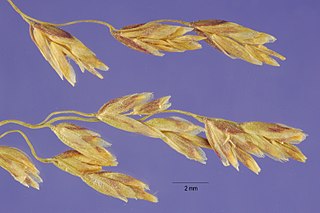
Scilla is a genus of about 30 to 80 species of bulb-forming perennial herbaceous plants in the family Asparagaceae, subfamily Scilloideae. Sometimes called the squills in English, they are native to woodlands, subalpine meadows, and seashores throughout Europe, Africa and the Middle East. A few species are also naturalized in Australasia and North America. Their flowers are usually blue, but white, pink, and purple types are known; most flower in early spring, but a few are autumn-flowering. Several Scilla species are valued as ornamental garden plants.

Scilloideae is a subfamily of bulbous plants within the family Asparagaceae. Scilloideae is sometimes treated as a separate family Hyacinthaceae, named after the genus Hyacinthus. Scilloideae or Hyacinthaceae include many familiar garden plants such as Hyacinthus (hyacinths), Hyacinthoides (bluebells), Muscari and Scilla and Puschkinia. Some are important as cut flowers.
In botany, an infraspecific name is the scientific name for any taxon below the rank of species, i.e. an infraspecific taxon or infraspecies. A "taxon", plural "taxa", is a group of organisms to be given a particular name. The scientific names of botanical taxa are regulated by the International Code of Nomenclature for algae, fungi, and plants (ICN). This specifies a three part name for infraspecific taxa, plus a connecting term to indicate the rank of the name. An example of such a name is Astrophytum myriostigma subvar. glabrum, the name of a subvariety of the species Astrophytum myriostigma.
The mantled mastiff bat is a species of bat in the Molossidae family endemic to Papua New Guinea.
Begonia secunda is a species of plant in the family Begoniaceae. It is endemic to Ecuador. Its natural habitat is subtropical or tropical moist montane forests. It is threatened by habitat loss.

Macrozamia secunda is a species of plant in the family Zamiaceae. It is endemic to New South Wales, Australia, where rainfall is fairly constant throughout the year. Its seeds are a reddish color and its fronds are generally somewhere between blue and grey in color.
Drimia namibensis is a species of plant that is endemic to Namibia. Its natural habitat is cold desert.
Valeriana secunda is a species of plant in the family Caprifoliaceae. It is endemic to Ecuador. Its natural habitat is subtropical or tropical high-altitude grassland.
Rhadamanthus was a just ruler in Greek mythology, son of Zeus and Europa.

Arctophila is a genus of Arctic and Subarctic plants in the grass family. The only known species is Arctophila fulva, commonly known as pendant grass, native to northern parts of Eurasia and North America.
Duthiea is a genus of Asian plants in the grass family.

Drimia is a genus of flowering plants. In the APG IV classification system, it is placed in the family Asparagaceae, subfamily Scilloideae. When broadly circumscribed, the genus includes a number of other genera previously treated separately, including Litanthus, Rhodocodon, Schizobasis and Urginea.
Drimia indica is a species of flowering plant found from South Asia to South Africa.

Fusifilum is a genus of bulbous flowering plants in the family Asparagaceae, subfamily Scilloideae. It is distributed in southern Africa. Some sources consider that all the species should be placed in the genus Drimia.

Drimia elata is a species of flowering plant in the family Asparagaceae, subfamily Scilloideae. It is widely distributed in eastern and southern Africa.

Drimia exuviata ("Gifbol") is a species of flowering plant in the family Asparagaceae, subfamily Scilloideae, indigenous to the south-western parts of South Africa.

Drimia capensis ("Maerman") is a species of geophytic flowering plant in the family Asparagaceae, subfamily Scilloideae, indigenous to the south-western parts of South Africa.
Drimia pancration is a species of plants in the family Asparagaceae. It is a bulbous geophyte native to the lands in and around the western and central Mediterranean, including mainland Spain, the Balearic Islands, Corsica, Sardinia, Sicily, Malta, mainland Italy, Tunisia, and former Yugoslavia.

Myosotis secunda, also known as the creeping forget-me-not is a species of flowering plant from the family Boraginaceae.










